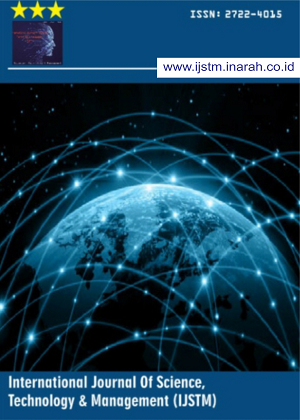Data Governance Integrative Strategy For Optimizing Poverty Reduction Programs In Garut District Using System Dynamic Modeling Approach
Abstract
The issue of overlapping poverty data among government agencies in Garut Regency has led to ineffective policy implementation. This study aims to analyze the factors influencing data governance and design an integrative strategy to optimize poverty programs through a System Dynamics Modeling (SDM) approach. Using a qualitative method, this research develops a stock-flow diagram to capture structural mechanisms in data governance. Data collection was conducted through interviews with key informants, historical data analysis, and a fuzzy scale, then analyzed using Vensim software. The model refers to Abraham's Data Governance Theory, which includes Data Scope (Traditional Data and Big Data), Domain Scope, Antecedents (Internal and External), Structural Mechanisms, Relational Mechanisms, and Procedural Mechanisms. The simulation results show that improving data quality, metadata management, effective communication, and strengthening roles and responsibilities across agencies significantly reduce data discrepancies. Additionally, better decision-making coordination and performance monitoring mechanisms enhance data accuracy. The findings emphasize the importance of integrating data governance strategies through cross-sector collaboration, consistent policy implementation, and a sustainable monitoring system. This integrative approach effectively addresses data overlaps and improves the accuracy and efficiency of poverty alleviation programs, serving as a model for other regions facing similar challenges.
Downloads
References
Abraham, R., Schneider, J., & Vom Brocke, J. (2019). Data Governance: A Conceptual Framework, Structured Review, And Research Agenda. International Journal Of Information Management, 49(July), 424–438. Https://Doi.Org/10.1016/J.Ijinfomgt.2019.07.008
Booth, A. (1992). Review Article The World Bank And Indonesian Poverty. 4(6).
Bps. (2023). Profil Kemiskinan Di Indonesia Maret 2023. Badan Pusat Statistik, 57, 1–8. Https://Www.Bps.Go.Id/Pressrelease/2018/07/16/1483/Persentase-Penduduk-Miskin-Maret-2018-Turun-Menjadi-9-82-Persen.Html
Gillingham, P., & Graham, T. (2017). Big Data In Social Welfare: The Development Of A Critical Perspective On Social Work’s Latest “Electronic Turn.” Australian Social Work, 70(2), 135–147. Https://Doi.Org/10.1080/0312407x.2015.1134606
Hurulle, G., Bamaramannage, S., & Lirneasia, H. G. (2023). Data For Poverty Measurement. September, 1–15.
Islamy, S. N., Anas, Z., & Mahsun. (2023). Kajian Perilaku Ketergantungan Penerima Program Keluarga Harapan (Pkh) Perspektif Qs. An-Nahl Ayat 53-55 (Studi Di Desa Krampon Kecamatan Torjun Kabupaten Sampang). Jurnal Ekonomi, Manajemen Dan Perbankan, 1(1), 59–70. Http://Altinriset.Com/Journal/Index.Php/Multifinance
Lu, W., & Zhang, W. (2024). Emotional Integration, Governance Capacity, And Poverty Alleviation In Relocated Communities: A Case Study Of Relocated Migrants In China. Journal Of The Knowledge Economy, 1–28.
Masuku, M. M., Mlambo, V. H., & Ndlovu, C. (2022). Service Delivery, Governance And Citizen Satisfaction: Reflections From South Africa. Journal Global Policy And Governance, 11(1), 97–116. Https://Doi.Org/10.14666/2194-7759-11-1-6
Niki, S., Larasati, E., Suwitri, S., & Warsono, H. (2020). Collaborative Governance In Poverty Alleviation In Ngada Regency, East Nusa Tenggara Province, Indonesia. Asian Social Science, 16(5), 72. Https://Doi.Org/10.5539/Ass.V16n5p72
Nugroho, A., Amir, H., Maududy, I., & Marlina, I. (2021). Poverty Eradication Programs In Indonesia: Progress, Challenges And Reforms. Journal Of Policy Modeling, 43(6), 1204–1224. Https://Doi.Org/10.1016/J.Jpolmod.2021.05.002
Nurkse, R. (1963). Masalah Pembentukan Modal Di Negara-Negara Jang Sedang Membangun. Bhratara.
Paik, K. E., Hicklen, R., Kaggwa, F., Puyat, C. V., Nakayama, L. F., Ong, B. A., Shropshire, J. N. I., & Villanueva, C. (2023). Digital Determinants Of Health: Health Data Poverty Amplifies Existing Health Disparities—A Scoping Review. Plos Digital Health, 2(10), E0000313.
Piliang, M. Z. (2023). Kemiskinan, Kesenjangan Pendapatan, Dan Bantuan Sosial. Attanmiyah: Jurnal Ekonomi Dan Bisnis Islam, 2(2), 262–284.
Ravallion, M. (2016). Are The World’s Poorest Being Left Behind? Journal Of Economic Growth, 21(2), 139–164. Https://Doi.Org/10.1007/S10887-016-9126-7
Staines, Z., Moore, C., Marston, G., & Humpage, L. (2021). Big Data And Poverty Governance Under Australia And Aotearoa/New Zealand’s “Social Investment” Policies. Australian Journal Of Social Issues, 56(2), 157–172. Https://Doi.Org/10.1002/Ajs4.129
Sugiharti, L., Purwono, R., Esquivias, M. A., & Jayanti, A. D. (2022). Poverty Dynamics In Indonesia: The Prevalence And Causes Of Chronic Poverty. Journal Of Population And Social Studies, 30, 423–447. Https://Doi.Org/10.25133/Jpssv302022.025
Suryahadi, A., Hadiwidjaja, G., & Sumarto, S. (2012). Economic Growth And Poverty Reduction In Indonesia Before And After The Asian Financial Crisis. Bulletin Of Indonesian Economic Studies, 48(2), 209–227. Https://Doi.Org/10.1080/00074918.2012.694155
Tirtosuharto, D. (2022). The Impact Of Fiscal Efficiency On Poverty Reduction In Indonesia: Institutional Factor And Geographical Differences. Journal Of Geographical Systems, 24(1), 67–93.
Copyright (c) 2025 International Journal of Science, Technology & Management

This work is licensed under a Creative Commons Attribution-ShareAlike 4.0 International License.
































